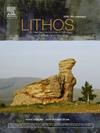Water content drives distinct evolution trajectory of Early Cretaceous granitoids in inland and coastal southeast China
IF 2.9
2区 地球科学
Q2 GEOCHEMISTRY & GEOPHYSICS
引用次数: 0
Abstract
Water plays a crucial role in determining the crystallization sequence of magma, which subsequently influences the chemical compositions of magmatic rocks across different tectonic settings. In this study, we compared the evolutionary features of granitic rocks along the coast and inland areas of southeast China, aiming to identify the key factors influencing their evolution. Our work indicates that multiple granitic intrusions formed between 126 and 142 Ma in the coastal region of southeastern China, which is consistent with the formation ages of large-scale granitoids in the inland Gan-Hang Belt. Isotopic characteristics suggest that the granitic rocks in southern Fujian originated from the melting of juvenile crust, while those in northern Fujian and eastern Zhejiang were formed from the partial melting of ancient crustal rocks, incorporating mafic magma evolved from the mantle. Most of the granitoids from the coastal region of southeastern China exhibit low zircon saturation temperatures (680–800 °C) and Zr/Sr ratios (<1), suggesting their origin from a cold, wet magma reservoir. The porphyritic quartz diorite and porphyritic monzogranite represent the residual cumulate rocks of this hydrous magma reservoir, whereas the granitic porphyry and high-silica equigranular alkali feldspar granite evolved from the felsic melts extracted from the same reservoir. In contrast, most of the Early Cretaceous granitoids in the Gan-Hang Belt, located in the inland areas of southeast China, display high zircon saturation temperatures (800–900 °C) and Zr/Sr ratios (>1), indicating their origin from hot, water-poor magma reservoirs. The porphyritic granites in this region represent residual cumulate rocks formed in water-poor magma reservoirs, whereas the high-silica equigranular granites evolved from hot felsic melts extracted from similar magma reservoirs. In the Early Cretaceous, the coastal region of southeastern China was closer to the Late Mesozoic paleo-Pacific subduction zone, where crystal-melt segregation within cold, wet magma reservoirs predominantly influenced magma evolution. Conversely, the granitoids in the Gan-Hang Belt in the inland region, located farther from the Late Mesozoic paleo-Pacific subduction zone, were associated with a rift tectonic setting and formed through crystal-melt segregation within hot, water-poor magma reservoirs. Our study underscores the critical role of water content in magma reservoirs in shaping the chemical composition of granitic rocks through crystal-melt segregation, thereby deepening our understanding of crustal formation processes across diverse tectonic environments.
含水量驱动中国内陆和东南沿海早白垩世花岗岩的不同演化轨迹
水在决定岩浆结晶序列方面起着关键作用,进而影响不同构造背景下岩浆岩的化学成分。本研究比较了中国东南沿海和内陆地区花岗岩的演化特征,旨在找出影响其演化的关键因素。我们的研究表明,中国东南沿海地区的多个花岗岩侵入体形成于126-142Ma之间,这与内陆赣杭带大型花岗岩的形成年龄一致。同位素特征表明,闽南地区的花岗岩石起源于幼年地壳的熔融,而闽北和浙东地区的花岗岩石则是由古地壳岩石的部分熔融结合地幔演化的岩浆形成的。中国东南沿海地区的大多数花岗岩显示出较低的锆石饱和温度(680-800 °C)和 Zr/Sr 比率(<1),表明它们起源于寒冷潮湿的岩浆库。斑状石英闪长岩和斑状单斜长花岗岩代表了这一含水岩浆储层的残积岩,而花岗斑岩和高硅等粒碱长石花岗岩则是从同一储层中提取的长英熔体演化而来。相比之下,位于中国东南内陆地区的赣杭带早白垩世花岗岩大多显示出较高的锆石饱和温度(800-900 °C)和Zr/Sr比值(>1),表明它们起源于高温、贫水的岩浆储层。该地区的斑状花岗岩是贫水岩浆储层中形成的残积岩,而高硅等粒状花岗岩则是从类似岩浆储层中提取的热长岩熔体演化而来。早白垩世,中国东南沿海地区更靠近中生代晚期的古太平洋俯冲带,冷湿岩浆储层中的晶体-熔体分离主要影响岩浆演化。相反,内陆地区赣杭带的花岗岩距离晚中生代古太平洋俯冲带较远,与断裂构造环境有关,是在热的、贫水的岩浆储层中通过晶体熔融分离形成的。我们的研究强调了岩浆储层中的水含量在通过晶体-熔体分离形成花岗岩岩石化学成分方面的关键作用,从而加深了我们对不同构造环境下地壳形成过程的理解。
本文章由计算机程序翻译,如有差异,请以英文原文为准。
求助全文
约1分钟内获得全文
求助全文
来源期刊

Lithos
地学-地球化学与地球物理
CiteScore
6.80
自引率
11.40%
发文量
286
审稿时长
3.5 months
期刊介绍:
Lithos publishes original research papers on the petrology, geochemistry and petrogenesis of igneous and metamorphic rocks. Papers on mineralogy/mineral physics related to petrology and petrogenetic problems are also welcomed.
 求助内容:
求助内容: 应助结果提醒方式:
应助结果提醒方式:


